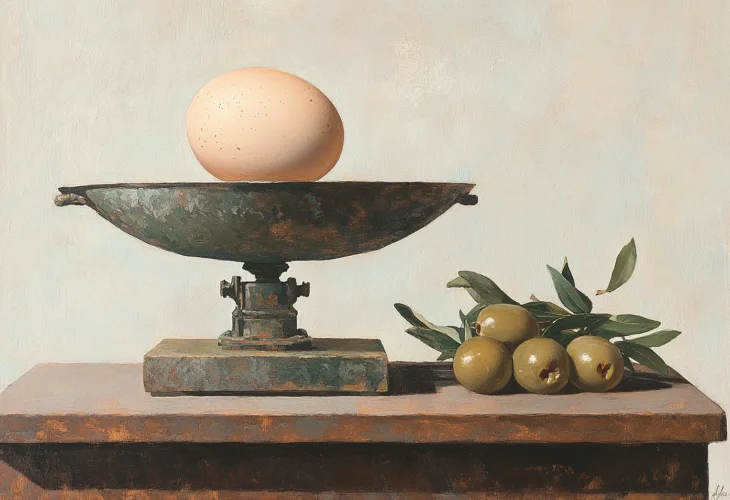Jewish Law
Torah Measurements and the Width of a Finger
What do olives and eggs have to do with mitzvah observance?

In "regular life," we measure in feet and inches, quarts and gallons. In halachic life, we measure according to Jewish law. You may have encountered measures such as a "k'zayit" -- the size of an olive or a "k'beitzah," which is the size of an egg. And what about an amah and a tefach?
Deciding how big an olive or an egg is will also depend on whether you're following the ruling of the Chazon Ish or Rabbi Chaim Na'eh. But what did people do before these two Torah leaders made their rulings? And is there a difference between Ashkenazi and Sephardi custom when it comes to measurements?
***
Making accurate measurements is necessary for the fulfillment of many different mitzvot. For example, one is not considered to have "eaten" unless at least a k'zayit has been consumed. If one eats at least a k'zayit, one makes a blessing before and after eating. And if someone unfortunately ate something forbidden, they are only liable for punishment if a k'zayit has been consumed.
When it comes to liquids, one can only fulfill the mitzvah of making Kiddush if the cup can hold at least a "revi'it" and at least that much wine was drunk. How much is a revi'it? It is a quarter of a "log," a liquid measure used in the time of the Sages.
Meanwhile, an etrog used on Sukkot must be at least the size of a "k'beitzah," the egg of a chicken.
Simple? Not quite. How do we measure an olive or an egg? There are many types of olives, and also many sizes of eggs... According to the Mishnah, a k'zayit is "a medium-sized olive according to the judgment of the observer." The same goes for an egg.
All these are measurements of volume , but there are also measurements of length. For example, a tefach is the width of a clenched fist. Three tefachim is the measurement of "lavud" for a sukkah, meaning that if there is a gap in the wall of the sukkah, as long as it measures less than three tefachim, the sukkah is still kosher. Five tefachim equal an amah, a measurement that also has great halachic significance.
So, is it all a matter of subjective judgment? Each person estimates with their own finger, their own tefach, their own amah, their own olive, and their own egg. Right?
Not quite. The Gemara provides us with more information on fingers and eggs. A vessel measuring "two fingers by two fingers, with a height of two-and-a-half fingers" contains a revi'it. The revi'it, you may recall, is a quarter of a log, and a log, according to the Sages, has the volume of six eggs. Conclusion: "Two fingers by two fingers by two-and-a-half fingers" equals one-and-a-half eggs.
The only thing missing before we can calculate the size of an egg is the correct measurement of a finger. This is where things start to get tricky.
Around a thousand years ago, the Geonim measured the egg and established measurements. Then came Maimonides (Rambam), who established the size of the egg relative to the measurements of the dirham, a coin that was in use in the Muslim Empire during his lifetime.
Using the measurement of the dirham, we get a small egg, and narrow finger widths.
However, if we assume that a finger means the average thumb in our day and age, we get a large egg...
Sephardic Jews, who always followed the rulings of the Rambam, measured only according to the dirham, and the resulting measurements were smaller, with a finger-width of just under 2 cm.
Ashkenazic Jews did not always follow the rulings of the Rambam, and the Muslim coin was not familiar in the lands where they dwelled, so doubts arose. Around 250 years ago, Rabbi Yechezkel Landau, the rabbi of Prague who was known as the "Noda BiYehuda," used a thumb-width to calculate the size of the egg and came to the conclusion that the prevailing custom was mistaken and that eggs should be measured according to the thumb. The implications were many; one was that challah dough would not be separated from a measure of 42 small eggs, but rather larger eggs.
Regarding the question of how it could be possible that the measurement of "k'beitzah" is larger than that of an actual egg, the Noda BiYehuda stated that perhaps eggs and olives have become smaller over time.
Many Ashkenazim follow the Noda BiYehuda in the matter of measurements. However, Sephardim follow the ruling of the Rambam and measure according to the dirham.
The dispute was reignited in the past century with the influx of Jews into the Holy Land. Rabbi Chaim Na'eh, who was of Ashkenazic descent but was also familiar with the dirham coin and the Sephardic custom, called for Ashkenazim living in the Land of Israel to accept the Sephardic custom and the "small measurement." The Chazon Ish, who immigrated from Lithuania to the Holy Land, disagreed and argued that the Ashkenazic custom and the "large measurement" were correct, because what determines halachah today is the actual measure of the thumb in our time, which is around 2.4 cm.
After lengthy and detailed discussions between all the great poskim of the previous generation, most of the world, especially Sephardim, follow the small measurement while trying to be stringent according to the large measurement when Torah laws are concerned (rather than laws of Rabbinic origin). And this is also the conclusion of the Mishnah Berurah.

